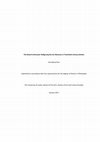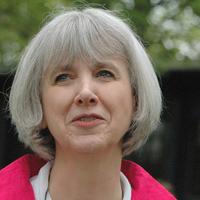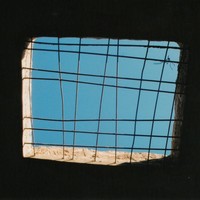Conference Presentations by Ana Baeza
Talk dealing with two main perspectives: a description of the physical occupation of a public sph... more Talk dealing with two main perspectives: a description of the physical occupation of a public sphere (Occupy London), and an investigation of the psychology of reasoning underlying the persuasive attempt of occupying that public space.
Peer-reviewed publications by Ana Baeza
Built Environment, vol. 39, no. 2 "Marketplaces as an Urban Development Strategy" (June 2013) pp. 313-15
Exhibition Reviews by Ana Baeza
One Stop Arts, Apr 5, 2013
Through her site-specific installation at the South London Gallery, Pae White recreates her exper... more Through her site-specific installation at the South London Gallery, Pae White recreates her experience of insomnia, invoking simple materials, visual abstraction and an investigation into the transience of language and time. These elements work together to transform the gallery into an immersive space that will surprise you at every turn.
One Stop Arts, Mar 22, 2013
In 1951, forerunner of Pop Art Barbara Jones opened an exhibition of popular British art titled "... more In 1951, forerunner of Pop Art Barbara Jones opened an exhibition of popular British art titled "Black Eyes and Lemonade". A powerful retrospective of Jones' legacy, “Black Eyes and Lemonade: Curating Popular Art” at the Whitechapel Gallery presents artefacts that cast a fresh eye on Jones' rejection of traditional museum hierarchies and connoisseurship.
One Stop Arts, Mar 14, 2013
Antoni Tàpies, the late Catalan painter, sculptor and art theorist, is showcased at the Timothy T... more Antoni Tàpies, the late Catalan painter, sculptor and art theorist, is showcased at the Timothy Taylor Gallery. The artworks on display are a play of surfaces and textures: they converse with one another and absorb the viewer into a tale about the magic of matter.
Book Reviews by Ana Baeza
International Journal of Heritage Studies, 2017
Thesis Chapters by Ana Baeza

Unpublished thesis (University of Leeds, National Gallery, London), 2017
The thesis critically investigates the ways in which art museums in Britain evolved their curator... more The thesis critically investigates the ways in which art museums in Britain evolved their curatorial techniques in the first half of the twentieth century, and it specifically charts the career of the scholar and museum director Philip Hendy (1900-1980), by focusing on the three museums under his care: Leeds City Art Gallery (1934-1945); Temple Newsam, Leeds (1938-1945); and the National Gallery, London (1946-1967). Through these case-studies, the thesis explores Hendy’s scheme to modernise these institutions during the interwar, wartime and post-war periods (1934-1956), and locates this reform in the context of changing discourses within the museum profession about the purpose of art museums in Britain.
Specifically, the investigation is concerned with the duality that was implicated in this agenda of modernisation, as museums aimed to democratise access to their collections with new display strategies and amenities for visitors, but whose efforts were at the same time characterised by a specialisation of curatorial practice which led to concerns about the status of the profession and the improvement of museum standards. The thesis thus articulates the increasingly professionalised endeavours in the museums under study, and examines how these informed, but also competed with, the concrete methods by which these galleries sought to open their doors to the interests of larger publics.
The focus of the investigation is on museum presentation - encompassing both architecture and display - which acted as a site of mediation between these professional and public spheres and shaped visitor engagement. As the thesis demonstrates, the curatorial techniques in the museums under review emphasised the need for museums to adapt to the demands of the present by updating their methods of exhibition, and secondly, they intended to make the collections visible to visitors qua viewers, in the belief that this would also make the museum more open and accessible.











Uploads
Conference Presentations by Ana Baeza
Peer-reviewed publications by Ana Baeza
Exhibition Reviews by Ana Baeza
Book Reviews by Ana Baeza
Thesis Chapters by Ana Baeza
Specifically, the investigation is concerned with the duality that was implicated in this agenda of modernisation, as museums aimed to democratise access to their collections with new display strategies and amenities for visitors, but whose efforts were at the same time characterised by a specialisation of curatorial practice which led to concerns about the status of the profession and the improvement of museum standards. The thesis thus articulates the increasingly professionalised endeavours in the museums under study, and examines how these informed, but also competed with, the concrete methods by which these galleries sought to open their doors to the interests of larger publics.
The focus of the investigation is on museum presentation - encompassing both architecture and display - which acted as a site of mediation between these professional and public spheres and shaped visitor engagement. As the thesis demonstrates, the curatorial techniques in the museums under review emphasised the need for museums to adapt to the demands of the present by updating their methods of exhibition, and secondly, they intended to make the collections visible to visitors qua viewers, in the belief that this would also make the museum more open and accessible.
Specifically, the investigation is concerned with the duality that was implicated in this agenda of modernisation, as museums aimed to democratise access to their collections with new display strategies and amenities for visitors, but whose efforts were at the same time characterised by a specialisation of curatorial practice which led to concerns about the status of the profession and the improvement of museum standards. The thesis thus articulates the increasingly professionalised endeavours in the museums under study, and examines how these informed, but also competed with, the concrete methods by which these galleries sought to open their doors to the interests of larger publics.
The focus of the investigation is on museum presentation - encompassing both architecture and display - which acted as a site of mediation between these professional and public spheres and shaped visitor engagement. As the thesis demonstrates, the curatorial techniques in the museums under review emphasised the need for museums to adapt to the demands of the present by updating their methods of exhibition, and secondly, they intended to make the collections visible to visitors qua viewers, in the belief that this would also make the museum more open and accessible.